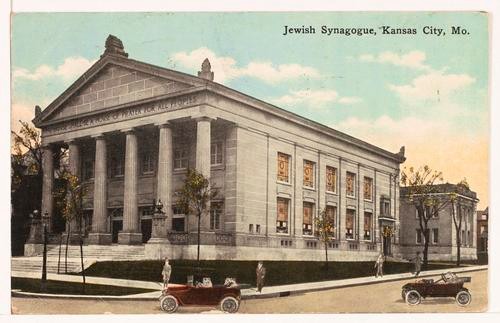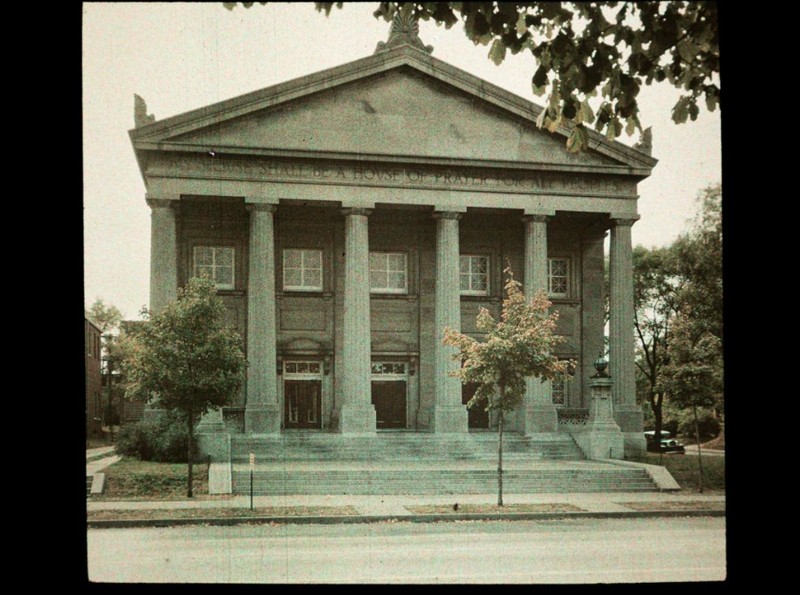Mohart Multipurpose Center, Formerly Congregation B'nai Jehudah
Introduction
Text-to-speech Audio
Completed in 1908, this building was the third to house Congregation B'nai Jehudah, Kansas City's oldest Jewish congregation. Inspired by the synagogues of other congregations in cities such as St. Louis and Cincinnati, the congregation chose to utilize a classical Greek Revival style, "following the examples of proportions of the Pompein Doric." The new building had even more seating capacity than the previous building, allowing the congregation's membership to grow even more over the years. B'nai Jehudah occupied this building until 1957 when they moved to a building further south at 69th and Holmes following a migrating congregation.
Images
Postcard of the B'nai Jehudah Temple at Linwood Boulevard and Flora Avenue.

Autochrome photograph of the B'nai Jehudah Temple, 1933. Above the entrance is written "My house shall be a house of prayer for all peoples."

Backstory and Context
Text-to-speech Audio
B'nai Jehudah's third house of worship took a year and a half to build and opened its doors on September 11, 1908. The structure was made of white stone and featured a Greek Revival style and according to members, it was "furnished magnificently throughout." Additionally, the structure included stained glass windows designed by renowned artist John La Farge, making this the architect's only design of a synagogue. Dr. Joseph Krauskopf, from a congregation in Philadelphia, read the first three verses of Genesis at the building's dedication. When he reached the third verse, "Let there be light," the congregation turned on the lights in their new home.
During its time in the Linwood building, Congregation B'nai Jehudah was served by two senior rabbis, Henry H. Mayer from 1908-1928 and Samuel S. Mayerberg from 1928-1957. Mayerberg is notable for being one of the first to speak publicly against the infamous Pendergast Machine beginning in 1932. His speech ran in the newspaper, and much of what he said was printed beneath the headline "Crooks Run the City." This began a battle against the political machine during which Mayerberg faced everything from harassment and ridicule to death threats and even assassination attempts. It took nearly a decade, but the Pendergast machine eventually fell in the early 1940s, in part thanks to the work of Mayerberg and his allies.
In the 1950s, many who lived in urban areas migrated outward, settling in Kansas City's surrounding suburbs. The Jewish community was especially a part of this, with many of them migrating to the less developed parts of town like south Kansas City. As a result, several area synagogues, including B'nai Jehudah, followed their congregations and set up new buildings closer to wherever they had moved. Their new building was at 69th and Holmes. The congregation moved there in 1957, and the building was completed in 1969 with the construction of a sanctuary. The Scottish Rite purchased the building. Eventually, they sold it to the Kansas City, Missouri, city government. Today the building is home to the Mohart Multipurpose Center and is rented by several government agencies and nonprofit organizations.
Cite This Entry
Rieber, Ellie and Clio Admin. "Mohart Multipurpose Center, Formerly Congregation B'nai Jehudah." Clio: Your Guide to History. November 15, 2022. Accessed April 26, 2025. https://theclio.com/tour/2331/5
Sources
The Linwood Boulevard Temple, The Temple, Congregation B'nai Jehudah. January 22nd, 2021. Accessed October 29th, 2022. https://www.bnaijehudah.org/2021/01/22/the-linwood-boulevard-temple/.
Adler, Frank J. Roots in a Moving Stream. 1972.
"B'Nai-Yehuda's Magnificent New Temple in Kansas City, Mo., will be Dedicated to the Service of God To-day." The Jewish Voice (St. Louis) September 11th, 1908. .6.
"Interesting Items." The Jewish Voice (St. Louis) July 4th, 1907. .7.
Coleman, Daniel. Samuel Mayerberg, The Pendergast Years - Kansas City in the Jazz Age and Great Depression. Accessed October 31st, 2022. https://pendergastkc.org/article/biography/samuel-mayerberg.
Missouri Valley Special Collections - Mrs. Sam Ray Postcard Collection (SC58)
Missouri Valley Special Collections - Frank Lauder Autochrome Collection

